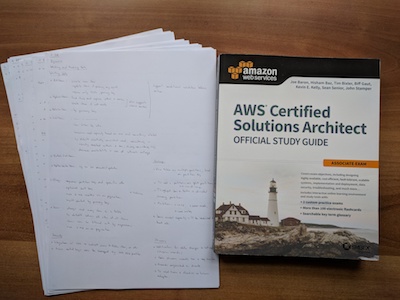Tips, tricks and study tips learned going half-way through the study guide to become an AWS Certified Solution Architect.
This post gives a status update on my journey to become AWS certified. I started studying about a month ago and described my motivations in a previous blog post. For the preparation, I’m using mainly the official study guide.
In this blog post, I want to share the lessons I learned and how I changed my study method to become faster and more productive.
Lessons learned
At the beginning, I was going through the book, reading a bit every evening, mainly after work before going to bed. For the introduction and the chapter about S3, the strategy worked well and I deluded myself that I could keep doing the same until the end.
The problem started when I added more and more material.
I started forgetting what I had already learned and I was jumping back often to rehearse details. My confidence in the practice questions decreased as well. I might look up the answers but I don’t have an infinite number of questions to bring all possible details to my attention.
So I went back to my old study method from university.
My study method
In university, I scored perfectly or nearly perfectly on every exam. My analytical and problem-solving skills have always been naturally sharp. My memory, on the other hand, just refuses to hold facts if they make no sense or are not presented in a linear way.
Therefore I had to develop a practical method to help me remember a lot of details. In the following paragraphs I will describe my personal strategy. If you want to read and dive deep in similar ideas, I recommend What Smart Students Know by Adam Robinson. The book has the worst cover design on earth but is filled with actual good content.
The main ideas of my study strategy are simple:
- Synthesize the material as much as you can.
- Avoid multiple passes on your book.
The first point is about taking notes and reorganize them in a way that makes the most sense to you. It is fundamental that the notes are written out and not just highlighted in the book. I also prefer hand-written notes. This will feel harder and that is exactly the point: it will force your brain to elaborate and store the information.
I take note of everything it is hard to remember, I need to clarify or reorganize visually. I don’t take note of facts I’m confident I already know or that are obvious.
For the second point, the second pass through a book is always boring. Your brain will cringe and it will affect your memory in a negative way. For this reason, the second pass should be from your notes only and, following the same logic, should ideally summarize the notes even further for a third pass. After some iteration, you will have only a couple of pages of notes, perhaps even only one.
On top of this, I also created a diagram of all the chapters and marked them with up to four tags: Read, Notes, Questions, Exercises. Each tag means, respectively, if I Read the chapter, if I took Notes for the chapter, if I answered the Questions at the end of the chapters and if I went through all its Exercises.
As you can see in the following table, I read, took notes and answered questions for the first seven chapter, that is half of the book. I’m a bit behind in the exercises though.
RNQE: Read, Notes, Questions, Exercises 1 Introduction: R 2 S3: RNQE 3 EC2, EBS: RNQ 4 VPC: RNQ 5 ELB, AS, CloudWatch: RNQ 6 IAM: RNQ 7 Database: RN 8 SQS, SWF, SNS: 9 DNS, Route53: 10 Elastic Cache: 11 Additional Services: 12 Security: 13 Risk and Compliance: 14 Architecture: R
My plan going forward
When I started studying for the exam, I estimated 3 months for the preparation. About a little more than a month after, I covered 7 chapters, that is, half of the book. That means I’m on schedule for now, though things like the Christmas break are not calculated.
For the readers that don’t own the official study guide, the first 7 chapters cover:
- EC2 classic, EC2-VPC, and EBS
- S3 and Glacier
- ELB, Autoscaling, and CloudWatch
- IAM
- RDS, DynamoDB, and Redshift
These topics, along with maybe Route53, make up the core of AWS. For this reason, I will spend some time getting a deeper understanding of them before moving on to new material. This includes finishing all exercises and perhaps building something to test my knowledge.
This is not strictly needed for the exam but, as I explained in my previous post, one of my goals is to gain a deeper understanding of AWS and not only getting an empty piece of paper.
Let me know in the comments below what you think about my plan, my study method or if you have any tricks and tips you want to share.
